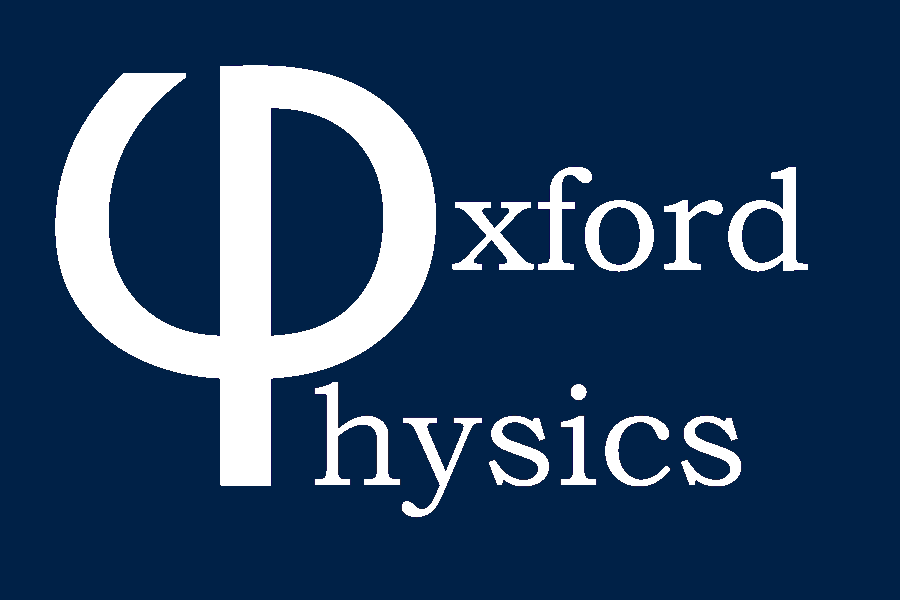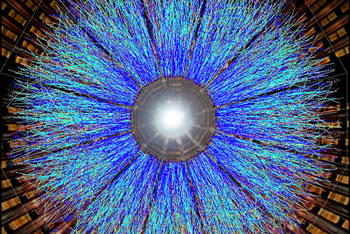Holography Seminar
Time and place: Tue 2-4pm, BIPAC Seminar Room
Michaelmas Term 2013 Talks:
- 29/10/2013: Andrew
O'Bannon
(U.Oxford):
A Holographic Model of the Kondo Effect
Abstract: The Kondo effect occurs in metals doped with magnetic impurities: in the ground state the electrons form a screening cloud around each impurity, leading to dramatic changes in the thermodynamic and transport properties of the metal. Although the single-impurity Kondo effect is considered a solved problem, many questions remain, especially about the fate of the Kondo effect in the presence of multiple impurities. In particular, for a sufficiently dense concentration of impurities, a competition between the Kondo effect and inter-impurity interactions can lead to quantum criticality and non-Fermi liquid behavior, which remains poorly understood. In this talk I will present a model of the single-impurity Kondo effect based on holography, also known as gauge-gravity duality or the AdS/CFT correspondence, which may serve as a foundation for a new approach to the multiple-impurity system.
- 05/11/2013: Han-Chih Chang (U.Washington) :
Entanglement Entropy for Probe Branes, the leading Backreaction
Abstract: Motivated by the vast utility of probe brane systems, we will review the notion of holographic quantum entanglement entropy, together with the extension thereof by probe brane systems through systematically taking the leading order backreaction of the probe branes into account.
- 12/11/2013: Thomas Vanel (Paris, LPTHE) :
Dressing the
electron star in a holographic superconductor
Abstract: Over the last five years, the gauge/gravity correspondence has been applied to describe quantum critical systems at finite density. The simplest model to consider is Einstein-Maxwell gravity, and the ground state of the system is described by Reissner-Nordstrom black hole where all the charge is carried by the black hole. However, it turns out that this solution is unstable to the formation of both fermionic and bosonic matter, corresponding in the dual field theory to the creation of a Fermi surface and the onset of superconductivity, respec- tively. We consider Einstein-Maxwell system coupled to a perfect fluid of charged fermions and a charged scalar field. In addition to the black hole, electron star and holographic super- conductor solutions, we find new asymptotically AdS4 solutions, dual to 2+1 CFTs at zero temperature and finite chemical potential, which contain both scalar hair and an electron star. We compute the free energy and show that these new solutions are thermodynamically favoured when they exist. Moreover, we find evidence for a continuous phase transition between the holographic superconductor and the new solutions.
- 19/11/2013:
Jorge Casalderrey-Solana (U.Barcelona & CERN) :
From Full Stopping
to Transparency in a Holographic Model of Heavy Ion Collisions
Abstract: We numerically simulate planar shock wave collisions in anti-de Sitter space as a model for heavy ion collisions of large nuclei. We uncover a cross-over between two different dynamical regimes as a function of the collision energy. At low energies the shocks first stop and then explode in a manner approximately described by hydrodynamics, in close similarity with the Landau model. At high energies the receding fragments move outwards at the speed of light, with a region of negative energy density and negative longitudinal pressure trailing behind them. The rapidity distribution of the energy density at late times around mid-rapidity is not approximately boost-invariant but Gaussian, albeit with a width that increases with the collision energy.
- 19/11/2013 Additional Seminar 5-7 pm, Room 501, DWB: Przemek
Witaszczyk
(U.Krakow)
: The nature of hydrodynamic gradient expansion in
holographic fluid
Abstract: The so called divergent series were once said to be "the devil's invention". However their true nature often reveals much more interesting and intricate structure than ordinary convergent series. The problem with convergence usually comes from some important physical reasons, not just inappropriate mathematical manipulations. The divergent series is often encountered in physics due to perturbative expansion, but in most of the cases its knowledge is limited to just first few accessible terms. In my talk I shall describe the nature of hydrodynamic gradient expansion obtained in fluid/gravity duality. The holographic computation of N=4 SYM theory stress-energy tensor in late time expansion allows to study the hydrodynamics of a gauge theory thermal state. As will be shown it also gives us rare explicit opportunity to study perturbative expansion of a physical system to a very high order. The hydrodynamic expansion will be shown to most likely be an example of asymptotic series. The reason for this, as remarked above, is physical and comes from non-equilibrium dynamics of the holographic fluid.
- 21/11/2013 Special Holography Seminar (Particle Theory Journal Club) 1 pm, Dalitz Centre, DWB: Chris Eling (AEI, Potsdam)
: Null surface geometry, fluid vorticity, and turbulence
Material: SlidesAbstract: I will review work over the past several years relating the dynamics of null horizons to hydrodynamics using the fluid/gravity correspondence. I will show how the fluid vorticity in 2+1 dimensions can be mapped into a geometric, gauge invariant quantity (a Newman-Penrose scalar) on the event horizon of a four dimensional black brane. I will use this result to characterize the horizon geometry dual to a turbulent flow and discuss the potential implications for the study of turbulent flows themselves.
- 26/11/2013: Christiana Pantelidou (Imperial College,
London) : P-Wave
Superconductors and Spatial Modulation
Abstract: The AdS/CFT correspondence is a very powerful tool for studying strongly coupled CFTs at finite temperature and charge density and/or magnetic field, commonly found in condensed matter physics. Two of the main focus in this direction is to get a better understanding of superconductivity and spatially modulated phases. In this talk, I will discuss how the two merge to give rise to spatially modulated superconducting p-wave states.
- 03/12/2013: Rob Myers (Perimeter
Institute, Canada)
: Quantum Quenches and Holography
Material: SlidesAbstract: We employ holographic techniques to study quantum quenches at finite temperature, where the quenches involve varying the coupling of the boundary theory to a relevant operator with an arbitrary conformal dimension. The evolution of the system is studied by evaluating the expectation value of the quenched operator and the stress tensor throughout the process. The time dependence of the new coupling is characterized by a fixed timescale and the response of the observables depends on the ratio of the this timescale to the initial temperature. The observables exhibit universal scaling behaviours when the transitions are either fast or slow, i.e., when this ratio is very small or very large. For fast quenches, we uncover a universal scaling behaviour in the response of the system, which depends only on the conformal dimension of the quenched operator in the vicinity of the ultraviolet fixed point of the theory.
- 03/12/2013 Additional Seminar 5-7 pm, Room 501, DWB: Hansjörg Zeller (Max Planck Institute,
Munich)
: Transport Properties of Holographic P-Wave Superfluids
Abstract: Due to the spacetime anisotropy of the holographic p-wave superfluid, the tensorial structure of the transport coefficients is non-trivial in contrast to the isotropic case. In particular, there is an additional shear mode which leads to a non-universal value of the shear viscosity even in an Einstein gravity setup. Furthermore, we find two optical conductivities with very different low frequency behaviour, one of which resembles a broad Drude peak. In this talk, I will present these phenomena and some other transport properties of this system.
- 10/12/2013: Yegor Korovin (U.Southampton)
: Lifshitz as a continuous deformation of Anti-de Sitter
Abstract: We consider holography for Lifshitz spacetimes with dynamical exponent z=1+epsilon^2, where epsilon is small. Тhe holographically dual field theory is a specific deformation of the relativistic CFT, corresponding to the z=1 theory. We set up the holographic dictionary for Einstein-Proca models and explain how renormalization turns the relativistic conformal invariance into non-relativistic Lifshitz invariance with dynamical exponent z=1+epsilon^2. Using only QFT arguments we show that a particular class of deformations of CFTs generically leads to Lifshitz scaling invariance and we provide examples of such deformations. An analytic Lifshitz black brane up to second order in ε is constructed. Relation to some top-down construction will be discussed.
If you are interested in presenting your research in Oxford, please contact Jonas Probst.

